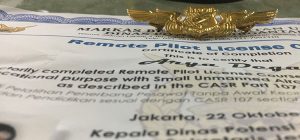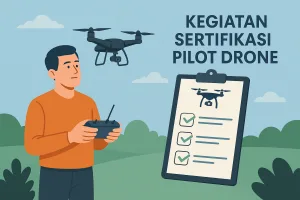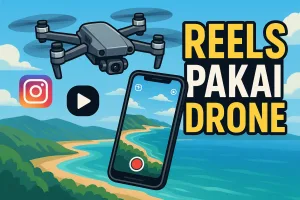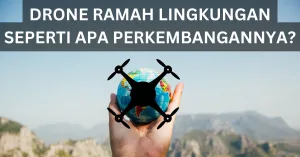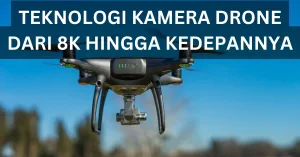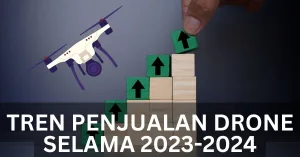![]()
Pertumbuhan penjualan drone di Indonesia semakin hari semakin meningkat seiring dengan banyaknya promosi drone-drone murah dan mudah didapat. Mulai dari harga 100 ribu rupiah hingga puluhan juta rupiah bisa anda dapatkan di toko-toko online lokal. Mulai dari drone mainan, drone racing, hingga drone profesional yang digunakan untuk profesi. Dalam peraturan pemerintah Indonesia yang tercantum dalam Peratuan Menteri Perhubungan yang mengatur menganai pesawat tanpa awak, sudah diatur dan dibedakan menjadi 2 macam keperluan sebuah drone:
- Untuk rekreasi, hobi, olah-raga, dan pendidikan. (CASR 107.2)
- Untuk komersial. (CASR 107)
Ohya, saya terangkan dulu bahwa singkatan CASR adalah Civil Aviation Safety Regulation, yaitu sebuah peraturan internasional keselamatan penerbangan sipil. Drone termasuk benda yang berada di ruang udara dan berhubungan dengan keselamatan penerbangan sipil karena drone bisa terbang tinggi banget.
Sedangkan isi dari CASR 107.2 untuk drone keperluan hobi adalah:
No person may operate UAS for recreation or hobby unless otherwise:
- the aircraft is flown strictly for recreational of hobby use;
- the aircraft is operated in accordance with a community-based organization;
- the aircraft is limited to not more than 15 pounds (7 Kg); and
- the aircraft are operated in accordance with Section 107.19, 107.23, 107.25, 107.27, 107.29, 107.31, 107.35, 107.37, 107.39, 107.41, 107.47, and 107.51 of this part.
Saya harus informasikan juga kepada anda bahwa saya tidak bisa menerjemahkan bahasa Inggris dari CASR karena dapat menimbulkan perbedaan arti dan maksud. Oleh karena itu, sebelum anda memutuskan untuk menjadi pilot drone maka anda WAJIB BISA BAHASA INGGRIS. Karena anda akan berurusan dengan ruang udara, maka anda harus mematuhi peraturan internasional yang berlaku ketat, dan juga digunakan oleh pemerintah Republik Indonesia dalam mengatur penggunaan ruang udara di Indonesia.
Okay saya lanjutkan lagi. Jika dilihat dari isi CASR 107.2 bagian (d), maka didalamnya terdapat 12 peraturan yang juga harus dipatuhi oleh pilot drone untuk keperluan hobi dan rekreasi. Sebentar…saya tidak melihat adanya istilah olah-raga dan edukasi dalam CASR 107.2, tapi sepertinya memang ditambahkan oleh pemerintah.
Berikut saya jabarkan satu per satu bagian (d) dari CASR 107.2 yang terdiri dari 12 part:
CASR 107.19:
Responsibility of the operator.
- The operator is directly responsible for, and is the final authority as to the operation of the small unmanned aircraft system.
- The operator must ensure that the small unmanned aircraft will pose no undue hazard to other aircraft , people, or property in the event of a loss of control of the aircraft for any reason.
CASR 107.23: Hazardous Operation.
No person may:
- Operate a small unmanned aircraft system in a careless or reckless manner so as to endanger the life or property of another; or
- Allow an object to be dropped from a small unmanned aircraft if such action endangers the life or property of another.
CASR 107.25: Operation from a moving vehicle or aircraft.
No person may operate a small unmanned aircraft system:
- From a moving aircraft; or
- From a moving vehicle unless that vehicle is moving on water.
CASR 107.27: Alcohol or drugs.
A person acting as an operator or as a visual observer must comply with the provisions of section 91.17 and section 91.19 of this chapter.
Section 91.17: Alcohol or drugs.
(a) No person may act or attempt to act as a crewmember of a civil aircraft:
(1) Within 8 hours after consuming alcohol;
(2) While under the influence of alcohol;
(3) While using any drug that affects the person’s faculties in any way contrary tosafety; or
(4) While having 0.04 percent by weight or more alcohol in the blood.
(b) Except in an emergency, no pilot of a civil aircraft may allow a person whoappears to be intoxicated or who demonstrates by manner or physical indicationsthat the individual is under the influence of drugs (except a medical patient underproper care) to be carried in that aircraft.
(c) A crewmember shall do the following:
(1) On request of a law enforcement officer, submit to a test to indicate thepercentage by weight of alcohol in the blood, when
(i) The law enforcement officer is authorized by law to conduct the test orto have the test conducted; and
(ii) The law enforcement officer is requesting submission to the test toinvestigate a suspected violation of a law governing the same orsubstantially similar conduct prohibited by Paragraph (a)(1), (a)(2), or(a)(4) of this section.
(2) Whenever the Director has a reasonable basis to believe that a person mayhave violated Paragraph (a)(1), (a)(2), or (a)(4) of this section, that personshall, upon request by the Director, furnish the Director, or authorize anyclinic, hospital, doctor, or other person to release to the Director, the resultsof each test taken within 4 hours after acting or attempting to act as acrewmember that indicates percentage by weight of alcohol in the blood.
(d) Whenever the Director has a reasonable basis to believe that a person may haveviolated Paragraph (a)(3) of this section, that person shall, upon request by theDirector, furnish the Director, or authorize any clinic, hospital, doctor, or otherperson to release to the Director, the results of each test taken within 4 hours afteracting or attempting to act as a crewmember that indicates the presence of anydrugs in the body.
(e) Any test information obtained by the Director under Paragraph (c)or (d) of thissection may be evaluated in determining a person’s qualifications for any airmancertificate or possible violations of the CASRs and may be used as evidence inany legal proceeding.
Section 91.19: Carriage Of Narcotic Drugs, Marihuana, And Depressant Or StimulantDrugs Or Substances
(a) Except as provided in Paragraph (b) of this section, no person may operate a civilaircraft within Indonesia with knowledge that narcotic drugs, marihuana, anddepressant or stimulant drugs or substances as defined by law are carried in theaircraft.
(b) Paragraph (a) of this section does not apply to any carriage of narcotic drugs,marihuana, and depressant or stimulant drugs or substances authorized by law ora national agency.
CASR 107.29: Daylight operation.
No person may operate a small unmanned aircraft system except between the hours of official sunrise and sunset.
CASR 107.31: Visual line of sight aircraft operation.
With vision that is unaided by any device other than corrective lenses, the operator or visual observer must be able to see the unmanned aircraft throughout the entire flight in order to:
- Know the unmanned aircraft’s location;
- Determine the unmanned aircraft’s attitude, altitude, and direction;
- Observe the airspace for other air traffic or hazards; and
- Determine that the unmanned aircraft does not endanger the life of property of another.
CASR 107.35: Operation of multiple small unmanned aircraft systems.
A person may not act as an operator or visual observer in the operation of more than one unmanned aircraft system at the same time.
CASR 107.37: Operation near aircraft; right-of-way rules.
- Each operator must maintain awareness so as to see and avoid other aircraft and vehicles and must yield the right-of-way to all aircraft, airborne vehicles, and launch and reentry vehicles.
- In order to maintain awareness so as to see other aircraft and vehicles, either the operator or a visual observer must, at each point of the small unmanned aircraft’s flight, satisfy the criteria specified in section 107.31.
- Yield the right-of-way means that the small unmanned aircraft must give way to the aircraft or vehicle and may not pass over, under, or ahead of it unless well clear.
- No person may operate a small unmanned aircraft so close to another aircraft as to create a collision hazard.
CASR 107.39: Operation over people.
No person may operate a small unmanned aircraft over a human being who is:
- Not directly participating in the operational of the small unmanned aircraft; or
- Not located under a covered structure that can provide reasonable protection from a falling small unmanned aircraft.
CASR 107.41: Operation in certain airspace.
Operator shall refer to Minister of Transportation Regulation concerning “Pengendalian Pengoperasian Sistem Pesawat Udara Tanpa Awak di Ruang Udara yang Dilayani Indonesia” with respect to operating UAS in Indonesian airspace.
CASR 107.47: Flight restrictions in the proximity of certain areas designated by notice to airmen.
No person may operate a small unmanned aircraft in areas designated in a Notice to Airmen under section 91.137, unless authorized by:
- Air Traffic Control (ATC); or
- A certificate of Waiver or Authorization issued by the DGCA.
Section 91.137: Temporary Flight Restrictions
CASR 107.51: Operating limitations for small unmanned aircraft.
An operator must comply with all of the following operating limitations when operating a small unmanned aircraft system:
- The airspeed of the small unmanned aircraft may not exceed 87 knots (100 miles per hour) calibrated airspeed at full power in level flight;
- The minimum flight visibility, as observed from the location of the ground control station must be no less than 3 statue miles (4.8 kilometers); and
- The minimum distance of the small unmanned aircraft from clouds must be no less than:
- 500 feet (150 meters) below the cloud; and
- 2,000 feet (600 meters) horizontally away from the cloud.
Cukup panjang bukan? Ini hanya peraturan yang mengatur penggunaan drone untuk kepentingan hobi dan rekreasi di Indonesia dan juga di seluruh dunia. Ada satu part yang belum saya jabarkan di halama ini yaitu section 91.137, mengenai temporary flight restriction. and bisa klik disini untuk melihat secara detilnya.
Sertifikasi pilot drone yang diadakan oleh Dispotdirga TNI-AU dan FASI yang saya ikuti, adalah sertifkasi pilot drone untuk kepentingan hobi, rekreasi, olah-raga, dan edukasi. Jadi, hingga artikel ini dipublikasikan saya belum memiliki sertifikasi pilot drone komersial di Indonesia. Untuk mendapatkannya maka saya harus menggali informasi lebih dalam lagi mengenai sertifikasi pilot drone komersial yang dikeluarkan oleh DKPPU (Direktorat Kelaikudaraan dan Pengoperasian Pesawat Udara).

